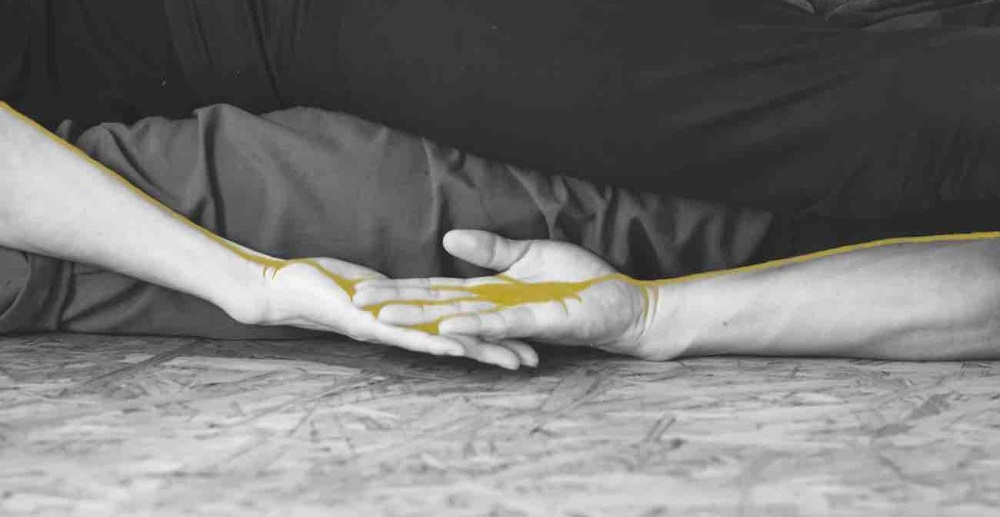With “Cassures Sublimées”, Morvarid K, Yuko Kaseki,and Sherwood Chen present a transdisciplinary hybrid of Butoh, photography,performance installation, and contemporary dance at Acker Stadt Palast.
An Ode to Imperfection
“Cassures Sublimées” begins like a photography exhibit of sorts, but with a traditional theater layout split into stage and grandstand. One photograph after another printed on paper slowly and silently floats across the stage, borne on the soft soles of performers Yuko Kaseki and Sherwood Chen. They are photographs featuring fairly nondescript motifs (cats perched on walls, sea waves), exhibited once upon a time many years ago and then no longer of interest to anyone. Literally disappeared and now once again pushed back into the focal point.
Accompanying this is the soft voice of Morvarid K, seated in the front row and speaking to the photographs: You do not exist. They told me you are not good enough. But I still love you. It is as if these photographs were denied the right to exist and are now being reborn on this stage, receiving their due recognition, even if they are not perfect and their dreams have been unexpectedly torn. Major themes like mortality and transience pervade the space. A quiet ode to the imperfect. You are beautiful. You are poetic. Beauty is not enough. Where is the twist?
Devotion and Expression
Yuko Kaseki crumples up one of the photographs with a painfully distorted expression. A theatrical gesture that suddenly signals an aesthetic transition between photographic installation and dance theater.
When Kaseki and Chen then move throughout the space, it is as if they are residing in foreign bodies. Heads hanging, extremities moving like marionettes, as if remotely operated like animated figures shifting through an other-worldly cyber landscape. Morbid images arise: manic glances and derailed expressions occasionally transition into the grotesque. Warped grimaces, narrowed eyes, and spastic, screwed up bodies recall cartoon characters who are able to stretch out their bodies like elastic, squiggling and compressing them together. From time to time, the somewhat abstract movements are once again detached from theatrical gestures, a hand grabs its own throat, a face distorted in pain, a body convulses and eventually falls to the floor.
What many people don’t know: Yuko Kaseki is a renowned Butoh star whose works have toured internationally. She has been living and working in Berlin since 1991(!). She develops performances outside of the funded world and presents these pieces in small project spaces or offstage. I must admit that the Butoh-esque aesthetic is sometimes beyond familiar interpretation. What is extraordinary is the poise of both performers. The utmost gravitas, absolute presence, and commitment to movement and expression, seem surrounded in a unique aura. The rejection of irony, the abandonment of coolness, the upright posture of the performers evokes sympathy from me. And yet something enigmatic and indecipherable remains.
Caught in a Time Loop
Overflowing stretches ensue, probably a result of the mixed genres. A performative installation has its own temporality, different from a theater piece.
Neverending improvisations with paper in a completely silent space put the audience to the test: a hunched over body trailing a long piece of paper, tearing up paper, mopping the floor with bits of paper, gathering up paper from the floor… The actions of the performers with this material are as concrete as they are banal, their movements routine, their posture not clearly defined – time seems to melt away. Now and then, exciting images flare up when Kaseki and Chen stand one behind the other and brandish giant crumpled up bits of paper, collapse into one another, and faces like grimaces emerge from the paper – a paper monster with two heads, four arms, and four legs.
The last half an hour is a sequence of eternal repetition: Chen executes an incessant and gruellingly long period of high jumps on the spot, which land on the photographs presented at the beginning of the piece. Over time, it all positions itself as something between performance art and exhibition space. The only problem is that we are in a theater. In this respect, this thoroughly intriguing work might have benefited from a time-structured, dramaturgical outside perspective.
English translation by Melissa Maldonado




